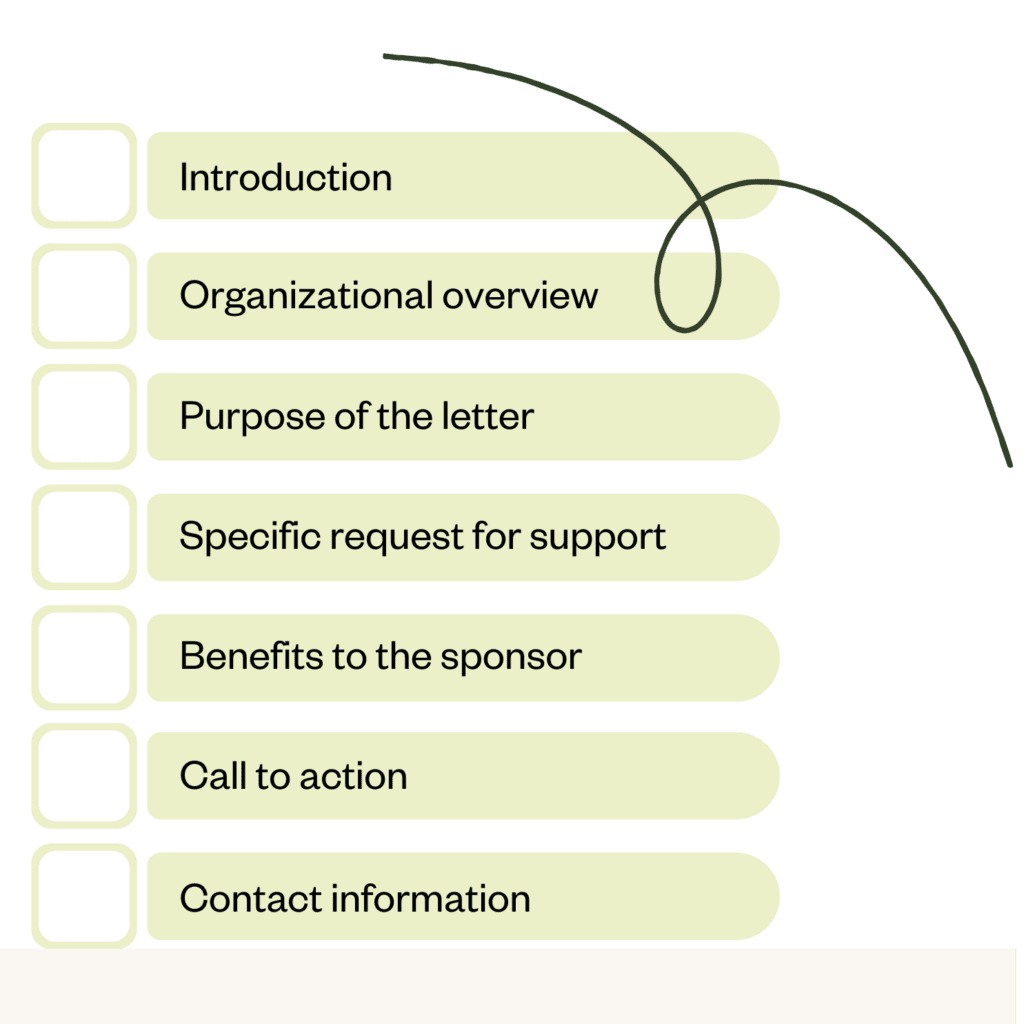
If your organization is looking to amplify your impact, sponsorships can be a game-changer. But how do you create valuable sponsor partnerships with companies, individuals, and other organizations in your community? Often, the starting point is a well-crafted sponsorship letter.
Sponsorship letters serve as the bridge between your organization and potential donors. These important letters can open the door to a long-term, mutually beneficial relationship that provides goodwill (or good advertising) to your sponsors, while helping you achieve your mission with financial or other resources.
This guide digs into the whats and hows of sponsorship letters to offer insights, examples, and best practices to help you develop or enhance your sponsorship cultivation efforts.
What is a sponsorship letter?
A sponsorship letter is an introductory request sent by an organization to a potential sponsor. In a sponsor fundraising letter, organizations seek financial support, in-kind donations, or other forms of assistance while also establishing a relationship with the company or organization they target.
It’s common for sponsorships to revolve around a specific event, but there are no limits to their potential. Sponsorship can also provide resources to support ongoing projects, programs, or operations.
While a standard donation request appeals to a prospective donor’s compassion as motivation to give, a sponsorship letter proposes a mutually beneficial relationship. This approach not only aids in fundraising but also fosters long-term partnerships that can be advantageous for both parties. Sponsors are typically offered public recognition, promotional opportunities, or other incentives in exchange for their support.
How to identify prospective sponsors
Writing a sponsorship letter starts with understanding who your prospective sponsors may be. A sponsor for your organization could be a for-profit company, a government institution, another nonprofit organization, a private foundation, or even an individual.
The best sponsorships often come through existing relationships. As you build a target list of prospective sponsors, consider the organizations and individuals with which you already have a direct relationship. Also consider those to whom you are connected through your staff, board, or volunteers. An existing connection can often help to establish or quickly elevate a sponsor relationship.
If you go beyond your inner circle for prospective sponsorships, consider companies and organizations that align with your mission. The best sponsorship prospects have already demonstrated an interest in your mission, whether through support for similar organizations or through their own work. Many companies want to get involved; community engagement through organizational partnerships is good advertising, provides employee volunteer opportunities, and builds a positive association with the community and consumers.
Once you’ve identified your potential sponsors, do your research! You’ll want to find out the best person to contact and how to contact them.
Key elements of a strong sponsorship letter
When you’re writing your sponsorship letter, there are some elements you don’t want to skip. An effective sponsorship request letter should encompass several key components:

- Introduction: You’ll want to begin your letter with a personalized greeting. Follow that with a compelling opening to capture the prospective sponsor’s attention.
- Organizational overview: Next, you’ll need to provide a brief background of your organization, especially if it’s a new partnership. Highlight your mission, achievements, and impact, especially as they relate to your request.
- Purpose of the letter: Businesses and organizations are more likely to respond favorably to a sponsorship letter if they understand what is being asked of them. State the reason for your sponsorship request, detailing the event or project in need of support, and how it will further your mission.
- Specific request for support: Here’s where you’ll specify the exact type and amount of support you are seeking, whether it’s financial assistance, in-kind donations, or volunteer involvement. Even if you’re sending a general sponsorship letter, be clear about what you need.
- Benefits to the sponsor: Outline the advantages the sponsor could receive through sponsorship. These often include brand exposure, goodwill in the community, an opportunity to get their employees engaged, or tax benefits. You can also tie these benefits to sponsorship levels—the more they give, the more they get.
- Call to action: Your call to action should offer a prospective sponsor clear next steps to advance the relationship. That may be scheduling a meeting, visiting your website to learn more about your organization, or completing an enclosed sponsorship agreement.
- Contact information: Finally, be sure to provide clear details on how the sponsor can reach you, whether through email, an online form, the phone, or mail.
How to tailor your sponsorship letter
Once you have the basics set, a sponsorship letter should be tailored in two ways, both reflecting your organization’s culture and mission and demonstrating an understanding of your potential sponsors. By connecting your organizational goals to a prospective sponsor’s interests and values, you can build a better case for a mutually beneficial relationship.
As you consider how to write your letter, think about what you have to offer as an organization and how that is potentially valuable to a prospective sponsor. Depending on the type of organization you represent, you may want to put a slightly different spin on your request.
- Nonprofits: As a nonprofit organization, you might emphasize the social impact and community benefits of the sponsorship. This includes showcasing how the sponsor’s support contributes to a meaningful cause, builds goodwill in the community, and contributes to a “halo effect” that puts their company in a good light with consumers.
- Healthcare organizations: If direct healthcare is your focus, you could appeal to organizations by describing the advancements in medical research, patient care improvements, or community health initiatives that the sponsorship will support.
- Educational institutions: Educational institutions like colleges and universities will likely want to focus on enhancing educational programs, providing scholarships for students, or improving facilities. Even more, you may want to describe how these efforts will benefit not just your students, but the broader community as well.
- Events: No matter what type of organization you’re raising money for, events are likely part of your fundraising or program strategy. In that case, you could highlight the event’s known or expected audience demographics, attendance figures, and any promotional opportunities that can provide valuable exposure for the sponsor.
Sponsorship letter templates and samples
Ready to dive in but not sure where to begin? Sponsorship letter templates provide a framework for you to start your sponsorship request letter. You’ll find one below, as well as a sample sponsor letter.
Sponsorship Letter Template
This sponsorship letter template incorporates the key elements of a strong sponsor letter outlined above.
[Date]
[Prospective Sponsor’s Name]
[Title]
[Company Name]
[Address]
[City, State, ZIP Code]
Dear [Potential Sponsor’s Name],
[Introduction: Engage the reader with a compelling opening that introduces your organization and its mission.]
[Organizational overview: Briefly describe your organization’s history, mission, and key accomplishments.]
[Purpose of the letter: Clearly state the purpose of the sponsorship request, detailing the event or project and its objectives.]
[Benefits to the sponsor: Use sentences or bullets to the specific benefits the sponsor will receive, such as brand exposure, community engagement, or other incentives.]
[Specific Request: Specify the exact type (financial, in-kind, or other) and amount of support you are seeking and how it will be utilized.]
[Call to Action: Encourage the sponsor to take the next step, providing clear instructions and contact information.]
[Closing: Express gratitude for their consideration and reiterate your enthusiasm for a potential partnership.]
Sincerely,
[Your Name]
[Your Position]
[Your Organization]
[Contact Information]
Sample Sponsorship Letter
This sample sponsorship request letter follows the above template to request in-kind support for a healthcare organization in Tampa, Florida.
March 31, 2025
Joshua Salazar
President & CEO
Tampa Medical Supply
555 E Madison Street
Tampa, Florida
Dear Mr. Salazar,
I hope this letter finds you well. My name is Rebecca Stanwick, and I am the Director of Medical Operations at Bay Health here in Tampa. At Bay Health, we are on a mission to provide exceptional healthcare services to our community. Our goal is to elevate the health of every Tampan, regardless of their financial situation. Since opening our doors in 1999, we have served more than 250,000 residents of our city with free or low-cost health care.
I am reaching out to explore a meaningful partnership with Tampa Medical Supply that would allow us to better serve the unhoused population in our city. We are specifically looking to secure an in-kind donation of basic medical and hygiene supplies that can be assembled into wellness kits and distributed throughout the community. Your generous contribution would help us to meet the ongoing needs of an underserved population in our community.
In recognition of your support, we would be honored to feature Tampa Medical Supply as a valued healthcare partner. This includes recognition on our website, social media shoutouts, signage in our facility, and acknowledgment in our donor newsletter. We believe this partnership aligns with your company’s commitment to health and wellness for all, and we would love to collaborate to make a lasting impact.
I would be grateful for the opportunity to discuss this partnership in more detail and explore how we can work together. Please feel free to contact me at (555) 555-5555 or rstanwick@tampabayhealth.co at your earliest convenience. Thank you for considering this request—we truly appreciate your time and support.
Warm regards,
Rebecca Stanwick
Director of Medical Operations
Bay Health Tampa
Best practices for writing a winning sponsorship letter
You only get one chance to make a great first impression. To enhance the effectiveness of your sponsorship proposal, consider the following best practices:
- Personalize it: Address the recipient by name and tailor the content to reflect their company’s values and interests.
- Be clear and concise: Be clear and to the point, avoiding jargon and overly complex language that your sponsor may not understand.
- Tell a compelling story: Share impactful stories or testimonials that illustrate your organization’s work and the difference sponsorship can make.
- Follow up: Don’t just wait for a response! After sending your sponsor fundraising letter, follow up with a phone call or email to discuss the opportunity further.
All sponsorship letters should be printed on your organization’s letterhead or sent from an official email address. Whether sent digitally or through snail mail, you want your prospective sponsors to feel confident in the legitimacy of your request—and your organization too.
Using technology tools for your sponsorship request process
Writing and customizing sponsorship letters can be a time-consuming process. Modern tools using artificial intelligence can help to make the process easier. AI can help you craft a first draft, streamline the process, and move you closer to the institutional dollars you need.
- Templates and automation: Thoughtfully-designed templates and CRM software can help to automate personalization and track your relationship with a sponsor. In a CRM, you can both craft and record your communications, track sponsorship payments, plan out benefit activations, and strategize on any follow-up to keep the relationship strong.
- Generative AI: Often, the hardest part about writing a sponsorship letter is just getting started. Tools like engage can assist in drafting and refining letters, offer insight into the organizations you’re planning to target, and provide suggestions to enhance the effectiveness of your letters.
- Data analytics: The use of advanced data insights and AI can help to identify potential sponsors whose interests align with your organization’s mission. This helps to ensure a more targeted outreach, saving you time and increasing the effectiveness of your efforts.
Common mistakes to avoid when writing a sponsorship letter
A well-crafted sponsorship letter increases the likelihood that your organization will receive funding or in-kind support. It also lays the foundation for long-term partnerships that can benefit your organization for years to come. To ensure that your sponsorship letters achieve these goals, you’ll want to avoid some of the most common mistakes that organizations make with sponsorship requests.
- Generic content: Don’t just print a stack of generic letters and drop them in the mail. Customization is key to connecting with and motivating potential sponsors.
- Unclear objectives: If you don’t clearly articulate the purpose of the sponsorship and how the funds or support will be utilized, a sponsor may not understand how—or why—they should help.
- Overlooking benefits to the sponsor: Sponsorships should always highlight what the sponsor stands to gain from the partnership.
- Neglecting the follow-up: Failing to follow up on your sponsorship letters can result in missed opportunities.
- Ignoring formatting and writing errors: Poorly formatted letters with grammatical errors can undermine your organization’s professionalism, causing a prospective sponsor to lose trust in the potential of the relationship.
The final word on sponsorship letters
Whether you’re a nonprofit seeking support for a community program, an event organizer looking for corporate sponsors, or a healthcare institution aiming to fund groundbreaking research, a compelling sponsorship letter can be the key to unlocking the resources you need.
By using the sponsorship letter templates, examples, and best practices outlined in this guide, you can craft persuasive letters that inspire action and build long-lasting partnerships in your community. After all, sponsorship letters are more than just requests for financial assistance; they are opportunities to create a deep relationship between your organization and your sponsors. By clearly articulating your needs, showcasing the value you can offer sponsors, using technology effectively, and maintaining a professional yet engaging tone, you can maximize the effectiveness of your outreach efforts—and your mission too.
Carolyn is a nonprofit-focused writer with more than 10 years of experience in non-profit and higher education event management, program development and management, prospect development, training, and data analysis.
Be the first to read our resources.
The world is changing quickly—and our resources help you stay on top of it all. Sign up to get new insights, success stories, and more, sent right to your inbox.



